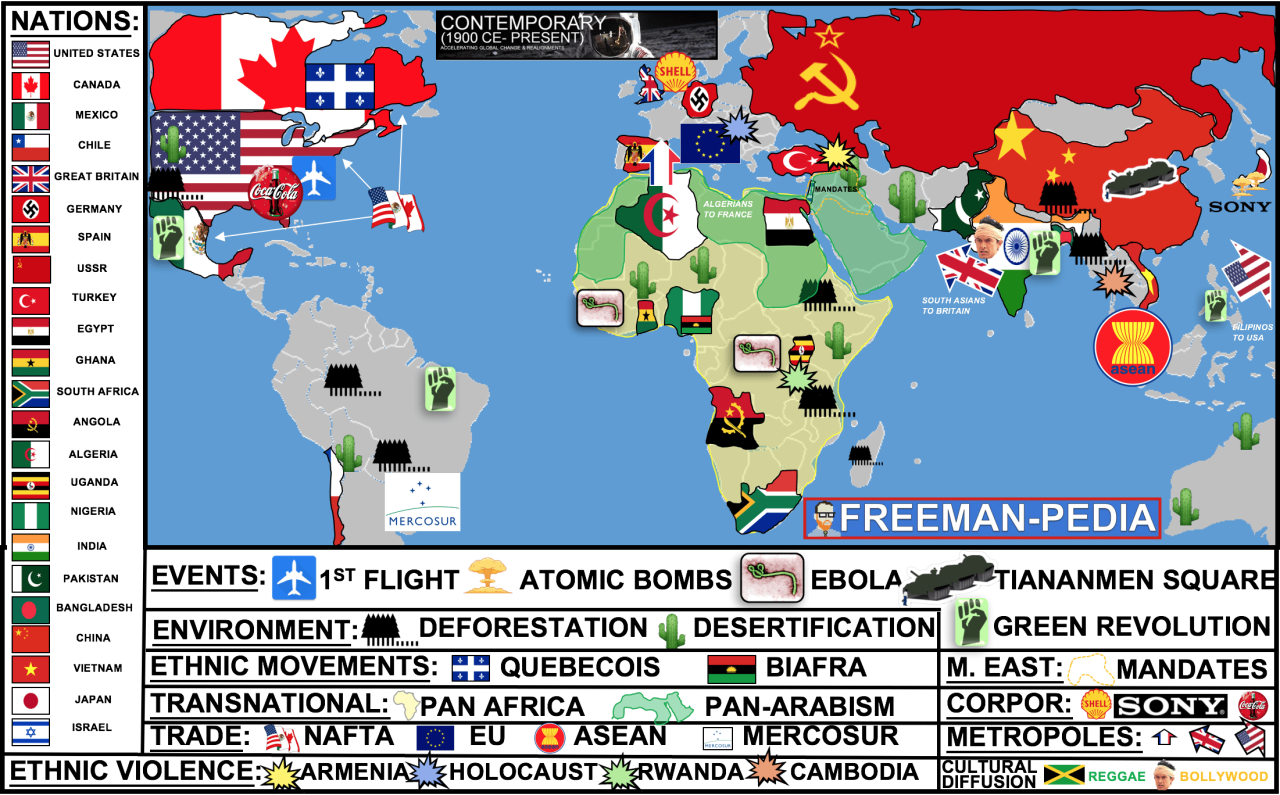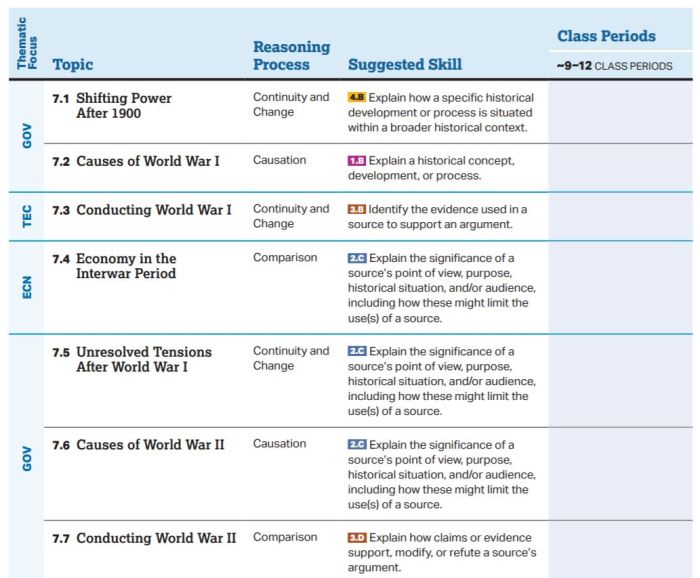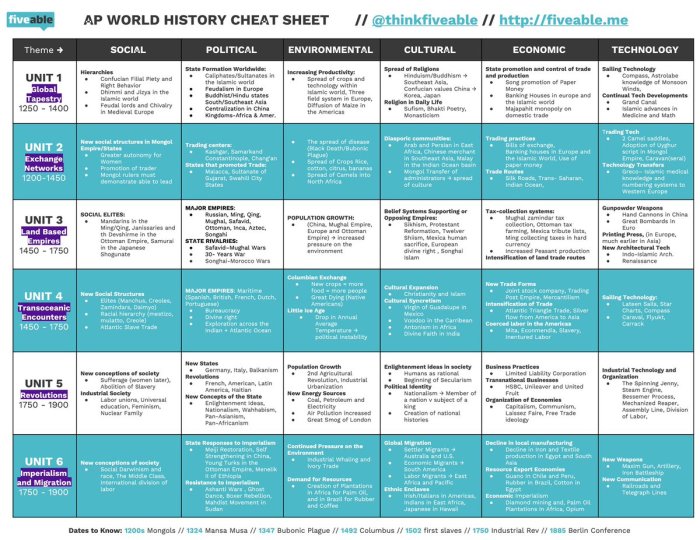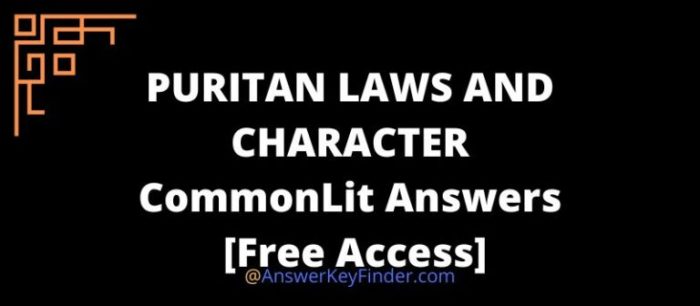Fiveable AP World Unit 8 transports us back to the tumultuous era of World War II, a conflict that reshaped the world’s political, economic, and social landscape. As we delve into this captivating unit, we’ll explore the intricate historical context that ignited the war, the major theaters of conflict, and the harrowing atrocities that unfolded during this dark chapter in human history.
Our journey through Fiveable AP World Unit 8 promises to be an intellectually stimulating experience, shedding light on the complexities of war, its devastating consequences, and its enduring legacy.
Historical Context of World War II

The outbreak of World War II, the deadliest conflict in human history, was the culmination of a series of complex events and factors that had been brewing for decades.Imperialism, nationalism, and economic factors all played a significant role in the build-up to the war.
European powers had been competing for colonies and resources around the world since the 19th century, and this competition had created tensions between them. At the same time, nationalism was on the rise in many countries, and this led to a desire for independence and self-determination.
Economic factors also contributed to the war, as the Great Depression of the 1930s led to widespread unemployment and poverty.
Timeline of Key Events Leading Up to World War II, Fiveable ap world unit 8
* 1914: World War I begins
1919
Treaty of Versailles ends World War I
1929
The Great Depression begins
1933
Adolf Hitler becomes Chancellor of Germany
1935
Italy invades Ethiopia
1936
Germany remilitarizes the Rhineland
1938
Germany annexes Austria
1939
Germany invades Poland, marking the beginning of World War II
Imperialism
Imperialism is the policy or practice of extending a country’s power and influence through diplomacy or military force. In the late 19th and early 20th centuries, European powers were competing for colonies and resources around the world. This competition led to tensions between the powers and contributed to the outbreak of World War I.
Nationalism
Nationalism is a sense of pride and loyalty to one’s country. In the 19th and 20th centuries, nationalism was on the rise in many countries. This led to a desire for independence and self-determination, and it contributed to the outbreak of World War II.
Economic Factors
The Great Depression of the 1930s led to widespread unemployment and poverty. This economic crisis contributed to the rise of fascism and Nazism in Europe. Fascism and Nazism are political ideologies that emphasize nationalism and militarism. They both played a role in the outbreak of World War II.
Major Theaters of War

World War II unfolded across multiple theaters, each with distinct battlefields, strategies, and impacts. These theaters included the Pacific, European, North African, Mediterranean, and Eastern Fronts, each witnessing pivotal battles and campaigns that shaped the course of the war.
Pacific Theater
The Pacific Theater encompassed a vast region stretching from Southeast Asia to the Pacific Islands. Key battles included the attack on Pearl Harbor, the Battle of Midway, and the island-hopping campaigns. The United States and Japan engaged in fierce naval battles, while Japan aimed to secure resource-rich territories in the region.
The Allies eventually gained the upper hand, culminating in the atomic bombings of Hiroshima and Nagasaki.
European Theater
The European Theater was the largest and most destructive, spanning from the Atlantic coast to the Soviet Union. The invasion of Poland marked the start of the war, followed by the Battle of Britain, the D-Day landings, and the Battle of the Bulge.
The Allies faced off against Nazi Germany and its Axis allies, employing combined arms tactics and strategic bombing campaigns. The Soviet Union played a crucial role in defeating Germany on the Eastern Front.
North African Theater
The North African Theater saw intense fighting between the Axis powers and the Allies. Key battles included the Battle of El Alamein and the Tunisia Campaign. The Allies sought to control the strategic Suez Canal and oil-rich Middle East, while the Axis aimed to secure North Africa as a base for operations.
The Allies eventually prevailed, pushing the Axis forces out of the region.
Mediterranean Theater
The Mediterranean Theater encompassed the Mediterranean Sea and surrounding areas. Key battles included the Battle of Taranto, the Battle of Crete, and the Italian Campaign. The Allies aimed to control the sea lanes and weaken Axis positions in Europe. The Italian Campaign involved a protracted struggle against German forces, ultimately leading to the liberation of Italy.
Eastern Front
The Eastern Front was the largest and most brutal theater of war, stretching from the Baltic Sea to the Caucasus Mountains. The Soviet Union faced the full force of the German invasion, known as Operation Barbarossa. Key battles included the Battle of Stalingrad, the Battle of Kursk, and the Vistula-Oder Offensive.
The Soviet Union’s resilience and scorched-earth tactics proved pivotal in defeating the German advance and ultimately liberating Eastern Europe.
The Holocaust and Other Atrocities

The Holocaust, the systematic genocide of approximately six million Jews by the Nazi regime and its collaborators during World War II, stands as one of the darkest chapters in human history. It was a meticulously planned and executed campaign of extermination driven by a twisted ideology of racial superiority and anti-Semitism.The
Nazis, led by Adolf Hitler, believed that the Jews were an inferior race that threatened the purity and strength of the German nation. They implemented a series of discriminatory laws and policies that gradually stripped Jews of their rights and freedoms.
As the war progressed, the persecution escalated into mass deportations to concentration and extermination camps, where millions of Jews were murdered in gas chambers or worked to death as slave laborers.The Holocaust was not an isolated event. Other atrocities were committed during World War II, including the genocides of the Roma (Gypsies), the mentally and physically disabled, and the Soviet prisoners of war.
These atrocities were driven by similar ideologies of racism, anti-Semitism, and nationalism, which justified the dehumanization and mass murder of entire populations.
Impact of World War II: Fiveable Ap World Unit 8

World War II had a profound and lasting impact on the world, shaping the political, economic, and social landscape for decades to come. It brought about significant changes in global power dynamics, the emergence of the Cold War, and left a lasting legacy that continues to resonate today.
Fiveable AP World Unit 8 takes a deep dive into the intricacies of the Cold War era. The complexities of international relations during this period are brought to life through compelling case studies, including the iconic film “12 Angry Men.”
In the film, Juror 5 ( juror 5 in 12 angry men ) serves as a powerful reminder of the importance of critical thinking and the value of dissenting opinions in shaping historical outcomes. By examining the dynamics within the jury room, Fiveable AP World Unit 8 encourages students to engage with the broader historical context and understand the profound impact of individual actions on global events.
Political Impact
The war led to the collapse of several major empires, including the British, French, and Japanese empires. This resulted in the emergence of new independent nations, particularly in Africa and Asia, and a shift in the global balance of power.
The United States and the Soviet Union emerged as the two dominant superpowers, setting the stage for the Cold War.
Economic Impact
The war had a devastating economic impact on many countries. The destruction of infrastructure, loss of life, and disruption of trade caused widespread economic hardship. However, it also stimulated economic growth in some countries, particularly the United States, which became the world’s leading economic power.
Social Impact
The war had a profound social impact, particularly on women and minorities. Women entered the workforce in large numbers to replace men who were fighting in the war, leading to increased economic independence and social change. The war also raised awareness of racial and ethnic discrimination, and contributed to the civil rights movement in the United States.
Legacy of World War II
The legacy of World War II is complex and multifaceted. It includes the establishment of the United Nations to prevent future wars, the Nuremberg Trials which held Nazi leaders accountable for war crimes, and the development of nuclear weapons which has had a profound impact on international relations.
The war also left a lasting scar on the collective memory of humanity, reminding us of the horrors of war and the importance of peace.
Historiography of World War II

The historiography of World War II is a vast and complex field, with a wide range of interpretations of the conflict. These interpretations have been shaped by a variety of factors, including the availability of primary and secondary sources, the political and ideological climate of the time, and the personal experiences of the historians themselves.
Primary and Secondary Sources
Primary sources are firsthand accounts of the war, such as diaries, letters, memoirs, and government documents. These sources provide valuable insights into the experiences of those who lived through the conflict. However, they can also be biased and incomplete, as they were often written with a specific purpose in mind.
Secondary sources are works of history that are based on primary sources. These sources provide a more comprehensive view of the war, as they can draw on a wider range of evidence. However, they can also be biased, as they are often written by historians with a particular point of view.
Areas of Ongoing Debate
There are a number of areas of ongoing debate in the field of World War II history. These include:
- The causes of the war
- The role of the United States in the war
- The impact of the war on the Holocaust
- The legacy of the war
These debates are likely to continue for many years to come, as new evidence is uncovered and new interpretations are proposed.
Essential FAQs
What were the key factors that led to the outbreak of World War II?
Imperialism, nationalism, and economic factors played significant roles in creating the tensions that ultimately erupted into war.
Which were the main theaters of war in World War II?
The major theaters of war included Europe, the Pacific, North Africa, and the Middle East.
What was the Holocaust, and what were its motivations?
The Holocaust was the systematic genocide of millions of Jews, Roma, and other minority groups by Nazi Germany. It was driven by racism, anti-Semitism, and the pursuit of a racially pure Aryan society.
What were the major political and economic consequences of World War II?
The war resulted in significant shifts in global power dynamics, the emergence of the Cold War, and widespread economic devastation.
How do historians continue to debate and research World War II?
Ongoing areas of debate and research include the role of individual leaders, the impact of technology, and the long-term consequences of the war.
